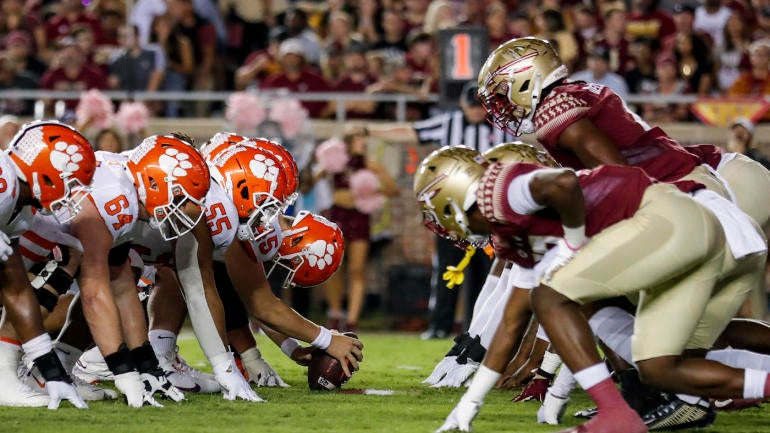
Florida State exploring a potential ACC exit was a curious move. After all, should the school even find a way to skirt around the conference's grant of rights agreement, there's not a clear path to wrangle itself into a higher payday in the SEC or Big Ten.
Insiders do not believe adding Florida State to one of those conferences makes much sense, financially, despite the program's strong brand. The Seminoles, by themselves, are not worth messing with the $60 million being handed out in revenue to SEC schools nor the $75 million getting paid out to Big Ten institutions.
That discussion has not only changed, but Clemson joining its conference rival in filing a lawsuit against the ACC this week -- challenging the grant of rights -- has given new life to another potential round of realignment.
Florida State and Clemson are a dynamic duo that could potentially trigger another shake-up across the college sports landscape. If the 'Noles and Tigers are deemed unworthy of Big Ten or SEC membership, perhaps even the Big 12 shows interest.
In December, I wrote that Florida State extracting itself from the ACC felt like a 5-10 year process. Now, you could perhaps move that timeline up a bit since there are two saber-rattling schools challenging the league. It seems only a matter of time before the three sides come to a negotiated resolution in the nine-figure range.
Florida State and Clemson feel they can, at worst, buy their way out of the current ESPN media rights deal that runs through 2036. The penalty to leave the conference would probably be a little less than the $572 million figure Florida State administrators calculated during a December 2023 meeting.
It's clear Florida State and Clemson don't want to be in the ACC. The three parties will co-exist, but they won't like it. Now, attention turns to whether the conference's financials can withstand the heat in the long term as the league has countersued both schools.
Both schools must officially leave the ACC before talks can begin with another conference. If not, get familiar with the phrase "tortious interference," which is a fancy legal term for tampering. You can bet ACC commissioner Jim Phillips has warned his Power Four peers to lay off illegal pursuits.
How far does this go without a clear direction for the insurgents? Sources told CBS Sports there is way too much credit being given to boosters, presidents and regents/trustees who are fueling this movement. The assumption, however, is that they know what they're doing.
Perhaps they don't, though. It's one thing to get out of the ACC; it's another to find a new home in a timely manner that makes financial sense in the long term.
Regardless, we're witnessing a slow separation of the haves and have nots. ESPN and Fox participated by providing the impetus behind Texas and Oklahoma moving to the SEC, while USC, UCLA, Washington and Oregon soon followed suit set to become Big Ten members in 2024.
The updated College Football Playoff revenue distribution model was another indicator of the SEC and Big Ten's reign as the ruling class in college football. Beginning with the new CFP media rights contract in 2026, Big Ten schools will be making a total of close to $100 million each, while the SEC will be somewhere around $80 million.
The most significant separator, however, will be inevitable settling of ongoing antitrust lawsuits against the NCAA and Power Five conferences.
Florida State and Clemson have made their intentions known, but who's next?
"If you have five or six other schools file a similar lawsuit, it's kind of like a pack of hyenas going after a lion," an ACC source told CBS Sports.
What's next in potential realignment?
Big-picture lookahead: Not much has changed since the U.S. Supreme Court deregulated college football television in 1984. The big winners from that decision were the Big Ten, SEC and Notre Dame, all of whom had the juice to negotiate their own television deals. Those three titans quickly capitalized and have the most lucrative TV deals to this day. FSU and Clemson want into that exclusive club. If the cost is destabilizing the ACC, well, we already live in a me-first society that is reflected by the me-first nature of college athletics.
It's become clear that rights holders value matchups and rivalries. Try to name a traditional football rivalry game that the SEC and Big Ten don't have at this point. Florida State-Clemson is one of the few answers. Miami-Florida State might be another. Other than those two, few aren't residing under their umbrellas.
That's why Florida State and Clemson together means so much. Not counting playoff or bowl games, rivalries accounted for 10 of the 11 highest-rated matchups last season. The only one not owned by the SEC or Big Ten -- as the leagues will look after realignment in July 2024 -- was Colorado-Colorado State. That, however, was pumped up by the Deion Sanders phenomenon.
If FSU and Clemson join the Big Ten or SEC together, would that be enough to move the dial? Sources told CBS Sports that it's doubtful -- at least in the near term.
What we're left with is a growing group of ACC schools that also want out. As the ACC has constantly reminded, those schools signed a 20-year contract in good faith with ESPN in 2016. The closer we get to expiration in 2036, the closer we get to the next round of realignment.
FSU and Clemson are attractive brands. They're just not attractive brands right now. The SEC has again decided to play eight conference games in 2025. If it ever moves to nine, let's say in 2026, the league will ask ESPN to be compensated for the extra game before considering the 'Noles and Tigers as expansion candidates.
In February 2025, ESPN can pick up an option on the ACC contract from 2027-36. Barring a legal maneuver that benefits FSU and Clemson in the next 11 months, it's hard to envision the network not making that move. Keeping the ACC together at the current price (just north of $40 million per team before CFP revenue) provides cost certainty, which is what the cable giants desire.
The AAU issue: FSU and Clemson are not AAU schools, which may or may not be a dealbreaker for the Big Ten. The league crowed about adding Nebraska from that elite academic club in 2011. A month later, Nebraska became the first school in the AAU's century-plus history to be kicked out.
Who could be next? If the 'Noles and Tigers extricate themselves, the aforementioned "hyenas" will likely follow. With compelling legal blueprints challenging the grant of rights emerging, other ACC schools are guaranteed to be watching these proceedings closely.
North Carolina would be high on any list -- perhaps even ahead of Florida State and Clemson. The UNC brand is among the most recognizable in sports. It was highly desired when Jim Delany was Big Ten commissioner, viewed as the most powerful figure in college sports. It would be desired in both the SEC and Big Ten today.
Miami fits in the Big Ten as an AAU school, but most of its football history is approaching ancient status. Could the Hurricanes' inconsistency on the field cost them a spot at the big-boy table? The SEC is already in the Sunshine State with Florida. Why would it want Florida State? Again, there's no guarantee those unhappy in the ACC would land in the Big Ten or SEC.
Battle of the titans: The ongoing media rights rivalry between ESPN and Fox must be considered amid realignment talk. The stakes have never been higher for the networks tied primarily to the Big Ten (Fox -- games also airing on CBS and NBC) and completely to the SEC (ESPN) at the top of the food chain. Further realignment threatens to upset the balance in what's basically become an AFC vs. NFC dynamic. Yes, they're that powerful. ESPN has the entire state of South Carolina (Clemson, South Carolina) and Florida (Florida, Miami, FSU) on its air for football. Why would it want to cede part of those viewing areas to Fox in realignment?
Networks don't want to reward schools for bailing out of their conference agreements, either. Texas, Oklahoma, USC and UCLA initially announced their intentions to leave at the end of their conference deals, while FSU and Clemson are suing more than a decade before their expiration dates. No network wants to be perceived as breaking up the ACC.
CFP deal prepared for realignment: FBS commissioners saw fit to insert language in the new CFP deal that allows for a contract "look-in" in 2028 should there be any "material" realignment. "Material" is currently undefined, but by any definition, FSU and Clemson changing conferences would cause the contract to be reopened and revenue distribution to be recalibrated.
We might as well refer to this "material" language as the Florida State Clause. Commissioners thought enough to reopen the deal at any time if major realignment occurred before 2028, a year in which there's already the look-in written into the contract. The Florida State Clause at least shows the commissioners' awareness that radical realignment could come sooner.
ACC composition: The main reason the ACC expanded last year was in preparation for this type of moment. The conference composition clause in the league's ESPN contract states the network can renegotiate if membership dips below 15 schools. That's why SMU, Stanford and California were invited to join in 2024.
The league will expand to 17 schools with those additions this season. Notre Dame is a member in all sports but football and hockey. Think of those three as a firewall against any defections. If the number dips below 15, ESPN could assert the remaining members of the ACC aren't worth the original price tag. That could signal the conference's demise.
Big 12 option: While the goal for FSU and Clemson is to join the Big Ten or SEC, the Big 12 could serve as a fallback plan. But if the 'Noles and Tigers aren't worth that $60 million per year number for the SEC, which seems to be the minimum cover charge to make a move, why would they take less money just to leave the ACC?
A Big 12 union seems possible if rightholders would be willing to increase the value of the league's media rights agreement; its teams are currently set to earn $32 million per year, lowest among the Power Four. That's a revenue gap of $28 million with the SEC and $43 million with the Big Ten.
Scheduling agreement with Big Ten, SEC: One industry source told CBS Sports a scheduling agreement between the Big Ten and SEC could be a longshot option on the table for Florida State and Clemson. But that would be stepping away from the guaranteed money -- no matter how small the figure -- in the ACC to become de facto independents.
Notre Dame has its scheduling agreement with the ACC because it needed access to bowls when the CFP debuted in 2014. The Fighting Irish also make somewhere between $60 million to $75 million in its combined NBC and ACC deals. Pac-12 castoffs Oregon State and Washington State are trying this on a smaller scale with the Mountain West.
FSU and Clemson are searching for more than just relevancy. They want to make a move that provides financial security for decades.
Private equity angle: Florida State has been public about its relationship with private equity firms that would finance a move out of the ACC. The problem is that private equity firms want a return on investment (ROI) typically in the area of 10% to 12%. It's one thing to buy out of the ACC, which is a pure expense, but It's another to make enough money in a new conference to pay off the private equity partner. Those firms may one day own the FBS. For now, it's hard to envision SEC commissioner Greg Sankey taking orders from anyone.
Looming legal threat: Further realignment should be accompanied by a giant caution sign for the Big Ten and SEC, which must balance their massive power after CFP revenue distribution was finalized. Together, they are getting 58% of the CFP revenue beginning in 2026, but they also control a much higher percentage of TV ratings, attendance and fan interest.
If the Big Ten and SEC are perceived to have any influence on FSU and Clemson leaving the ACC for their leagues, antitrust implications coming out of Washington, D.C. may soon follow.
"At what size are you too big that Department of Justice looks at you cross eyed [meaning] you control too much market size?" one industry source told CBS Sports.





















